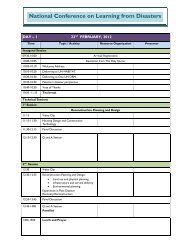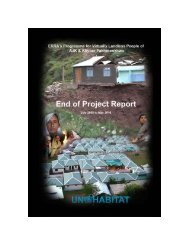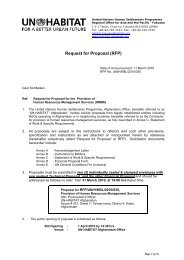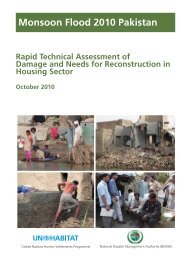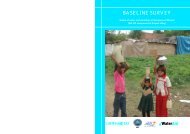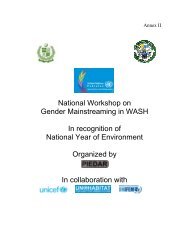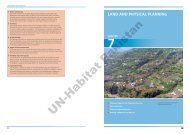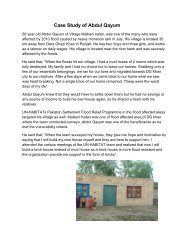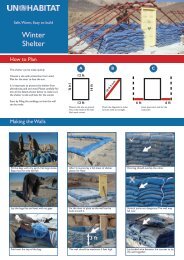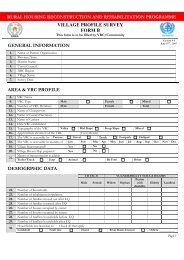Pakistan Floods OCHA sitrep 27 (24 Sept 2010). - UN-HABITAT ...
Pakistan Floods OCHA sitrep 27 (24 Sept 2010). - UN-HABITAT ...
Pakistan Floods OCHA sitrep 27 (24 Sept 2010). - UN-HABITAT ...
You also want an ePaper? Increase the reach of your titles
YUMPU automatically turns print PDFs into web optimized ePapers that Google loves.
III. Humanitarian Needs and Response<br />
Camp Coordination and Camp Management<br />
Response: Good progress has been made on the joint planning of a camp profiling exercise in Sindh (PDMA,<br />
CCCM cluster and <strong>OCHA</strong>). A questionnaire has been endorsed and the methodology has been finalized with<br />
the National Commission for Human Development (NCHD), which will implement the project with support<br />
from the cluster lead. The exercise will be completed within ten days. The cluster continues to identify NGO<br />
partners to act as district-level CCCM focal points. Therefore, interested NGOs are highly encouraged to<br />
approach the cluster in Sukkur and Hyderabad. Three organized camps are being developed by district<br />
authorities in Dadu district, each hosting 500 families. Participatory Efforts for Healthy Environment, a local<br />
NGO, will implement the project. In Balochistan a system to map and profile camps has been finalized. The<br />
Baloch Rural Support Programme estimates that data collection will be complete in one week. District<br />
authorities in Nasirabad district in Balochistan, have requested the establishment of two camps, at Sohbatpur<br />
and Chattan Patti (250 families each). Hygiene conditions in camps in the district have improved. In Punjab,<br />
the Provincial Emergency Commissioner has released figures indicating that the numbers of people in<br />
temporary camps and schools is rapidly decreasing, confirming the need for scaled up shelter support in<br />
return areas.<br />
Gaps and Constraints: Despite progress on camp profiling, there continue to be significant gaps in information<br />
about the locations and populations of camps. It has been noted that in Balochistan new families are moving<br />
into camps as others return, as alternative accommodation is not available. These movements in and out of<br />
camps pose significant challenges.<br />
Education<br />
Needs: The number of schools reported as being used as shelters across the country has decreased further;<br />
692,000 people are now staying in 3,122 schools. Some 9,970 schools are now reported as damaged by the<br />
floods. Previously reported education needs persist – including temporary school structures, school supplies,<br />
tents, school-in-a-box kits and recreation kits – to ensure continuation of education during the transitional<br />
period.<br />
Response: The number of temporary learning centers (TLCs) established by the cluster has reached 454<br />
(benefiting 38,879 children). Some 415 adult literacy centers are benefiting 7,028 flood-affected adults. The<br />
cluster has distributed 396 school-in-a-box-kits, 503 recreation kits, <strong>27</strong>,753 school bags and a variety of other<br />
essential school supplies in flood- affected districts across the country. The cluster reports that the army plans<br />
to rehabilitate a total of 170 flood-damaged schools in Punjab’s D.G. Khan, Muzaffargarh, Rajanpur, Layyah<br />
and Multan districts. This work is already underway in 75 schools. 32 TLC teachers and NGO volunteers<br />
participated in a first phase of training in Hyderabad in Sindh. The Sindh provincial government has released<br />
funds for the initial cleaning and fumigation of schools in Khairpur and Sukkur districts.<br />
Food<br />
Needs: Preliminary results of rapid needs assessments in KPK, Punjab, Sindh and Balochistan suggest that<br />
10 million people are in need of food assistance. Further assessments are ongoing and will give a clearer<br />
picture of the numbers requiring food support, both in the forms of relief and early recovery.<br />
Response: The cluster is distributing both food rations and cash transfers to allow affectees to purchase food.<br />
Ready-to-use supplementary food is also being provided for children between the ages of 6 and <strong>24</strong> months,<br />
and high-energy biscuits to those aged between 2 and 12 years. Since the beginning of the flood response, it<br />
is estimated that at least 107,000 metric tonnes have been distributed to people in need. The Food Cluster is<br />
collaborating with the WASH and Health Clusters in the development of a survival strategy to ensure a more<br />
integrated, effective and timely survival response in priority flood affected districts.<br />
Gaps and Constraints: While many donors have announced pledges, the food cluster urges them to confirm<br />
their donations in order to ensure that sufficient food can be purchased and pre-positioned in target locations<br />
for October. WFP, which is providing 66 percent of current food assistance, is facing a shortfall of US$379<br />
million for its revised emergency operation, with a pipeline break expected in October <strong>2010</strong>. US$140 million<br />
The mission of the United Nations Office for the Coordination of Humanitarian Affairs (<strong>OCHA</strong>) is to mobilize and coordinate effective<br />
and principled humanitarian action in partnership with national and international actors.<br />
2



